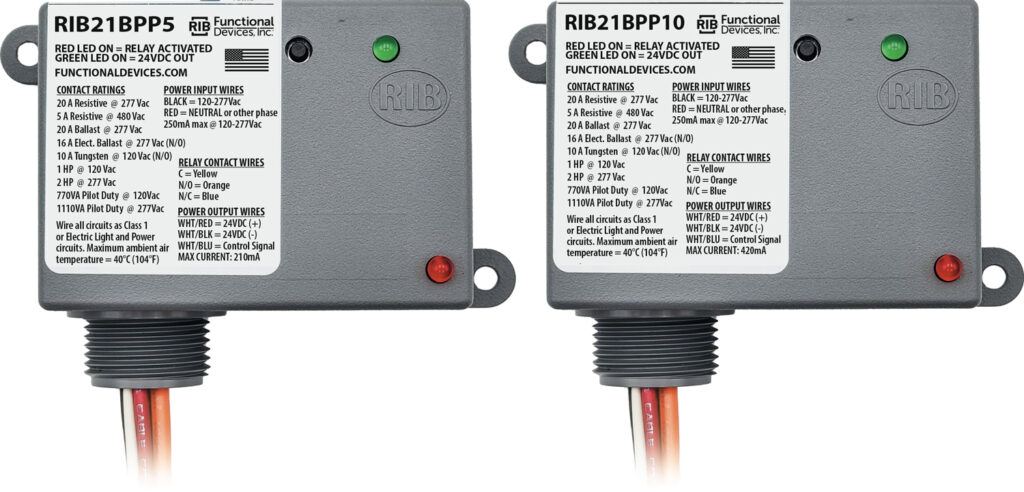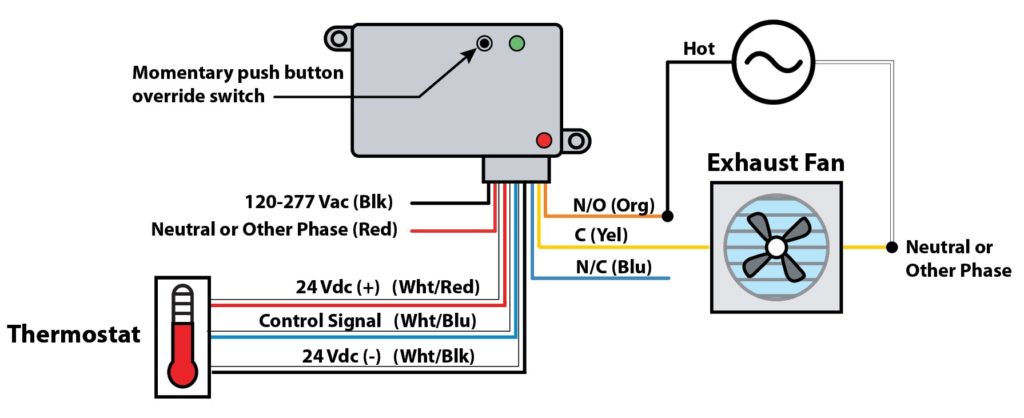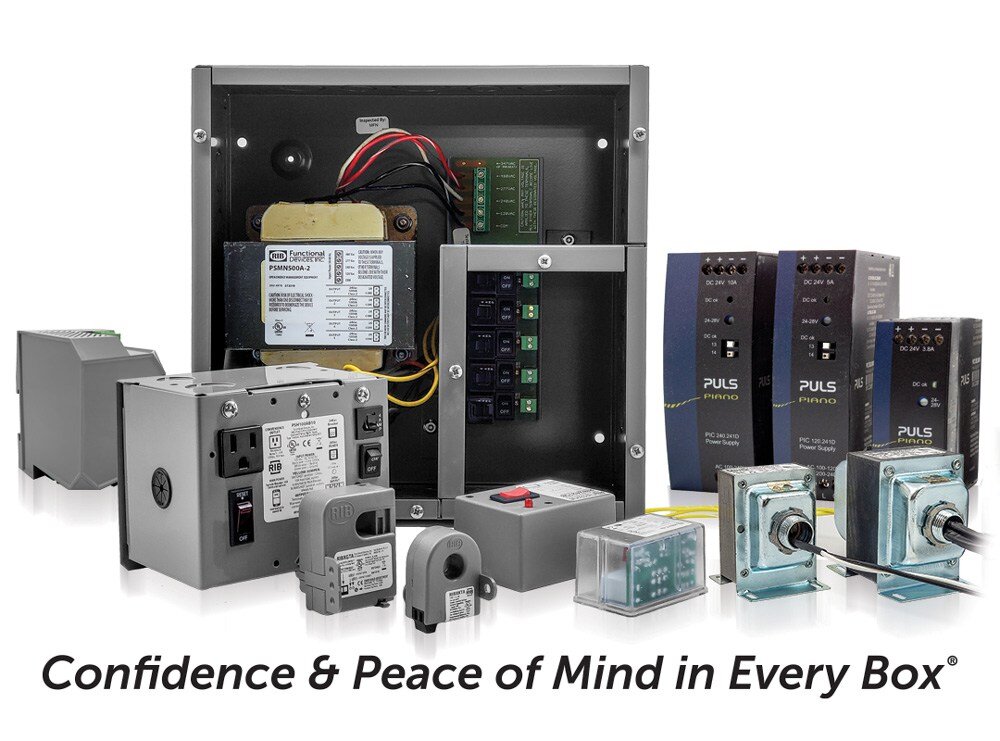

As building automation systems (BAS) evolve, the demand for low-voltage power sources and reliable switching solutions grows. Sensors, controllers, and peripherals all require dependable power while still needing to control higher-voltage loads. That’s where RIB® relays and DC power packs come in.
Designed by Functional Devices, these components streamline installation, improve reliability, and simplify power distribution in complex systems. Functional Devices engineers and manufactures a wide range of RIB relays and power supplies in the USA, offering products tailored to modern BAS needs. Explore our RIB power packs today or reach out for help finding the best model for your project.
In this blog, we’re exploring all the useful details you need to know about RIB power packs.
Why RIB Power Packs Matter
RIB power packs provide low-voltage power to today’s ever-growing sensor systems while also switching line voltage loads. They’re essentially two devices in one: a Class 2-rated 24Vdc power supply and a high-current relay for controlling loads like lighting, fans, or HVAC equipment.
This combined approach means fewer components to mount and wire, saving both space and labor. It also ensures compatibility with the most common control voltages in building automation.
Core Features of RIB Power Packs
With an on-board 20 Amp rated relay, RIB power packs come ready to switch line voltage to your load when the low voltage control signal is received. Check out some of the features!
- On-board 20 Amp rated SPDT relay
- Requires input power anywhere between 120-277Vac
- 24Vdc, Class 2 rated output
- Model RIB21BPP5 (5W) provides up to 210mA @ 24Vdc
- Model RIB21BPP10 (10W) provides up to 420mA @ 24Vdc
- Prepackaged: Wires, LED indicators, momentary push button override switch, NEMA 1 enclosure
- UL Listed and Made in the USA with Global Materials

By combining these specifications, RIB power packs deliver both power and control in one device, reducing the need for separate transformers and relays.
How RIB Relays & Power Packs Work Together
A typical power pack houses a relay coil powered by the low-voltage Class 2 output. When a control signal (often from a BAS controller or occupancy sensor) is applied, the relay closes and switches line voltage to the connected load. This architecture allows building automation designers to:
- Power sensors and controllers directly from the power pack.
- Control lighting or HVAC loads without a separate relay enclosure.
- Simplify wiring by running a single low-voltage control line to the pack while maintaining line-voltage separation inside.
This approach eliminates the need for separate transformer-based power supplies and stand-alone relays, saving time during installation and reducing failure points.
Tips for Specifying the Right Power Pack
Selecting the right RIB power pack is critical to ensuring system stability and safety. Before specifying a model:
- Verify load voltage and current to ensure the on-board relay can handle it (up to 20A at line voltage).
- Calculate low-voltage current demand for sensors or controllers to choose between the 5W or 10W version.
- Check enclosure and mounting requirements (NEMA 1 enclosure provided standard).
- Account for wiring distances on the low-voltage side to avoid voltage drop.
Correct specification prevents nuisance trips, undersized power outputs, or wiring issues that can compromise system performance.
Practical Applications in BAS
RIB relays and DC power packs are used in a wide range of real-world scenarios, including:
- Lighting Control. Occupancy or daylight sensors trigger the power pack, switching lighting circuits while simultaneously powering control devices.
- HVAC Equipment. Low-voltage controllers operate fans, pumps, or dampers with the power pack supplying both control power and relay switching.
- Retrofit Projects. A single enclosure simplifies upgrades where space and wiring options are limited.
- Sensor Integration. Multiple low-voltage sensors can be powered from one pack while a single relay switches the load.
In each case, installers save time, reduce component counts, and avoid costly callbacks by using a combined solution.
Advantages of Using RIB Power Packs
Beyond technical specs, RIB power packs address real-world installation and maintenance challenges:
- Fewer devices to mount and wire, reducing labor costs.
- Built-in push-button override switch simplifies testing during commissioning.
- LED indicators provide instant visual feedback on relay status and power output.
- Class 2-rated output ensures compliance with electrical codes while simplifying wiring.
Together, these advantages mean quicker installations, cleaner control panels, and more reliable long-term operation.
RIB Power Pack FAQ
As building automation systems become more complex, installers and engineers often have detailed questions about how RIB power packs work in real-world scenarios. This FAQ addresses some of the most common technical topics to help streamline design, installation, and troubleshooting.
Q: Can RIB power packs power sensors and control a load at the same time?
A: Yes. Each power pack combines a 24Vdc Class 2 power supply with a 20A SPDT relay. This allows it to provide low-voltage power to sensors or controllers while simultaneously switching line voltage to the connected load.
Q: How do I decide between the RIB21BPP5 and RIB21BPP10 models?
A: The RIB21BPP5 delivers up to 210mA at 24Vdc (5W), while the RIB21BPP10 provides up to 420mA at 24Vdc (10W). Choose based on the total current your sensors or controllers will draw.
Q: Are RIB power packs compatible with both 120Vac and 277Vac systems?
A: Yes. The input voltage range is 120–277 Vac, so one device can be used across a variety of building automation applications without the need for multiple SKUs.
Q: Can the on-board relay handle inductive loads?
A: The relay is rated for 20A general use at line voltage, but for highly inductive loads like motors, ensure you check inrush ratings or use an appropriate contactor to prevent premature wear.
Q: What’s the benefit of the push-button override switch?
A: The override switch allows technicians to manually activate the relay without sending a control signal. This is useful for troubleshooting during commissioning or verifying load operation.
Q: How does using a RIB power pack reduce installation time?
A: By combining the power supply and relay in one enclosure, wiring is simplified. Fewer components mean fewer terminations, less conduit, and reduced panel space requirements.
Q: Are the 24Vdc outputs Class 2 rated for code compliance?
A: Yes. The Class 2 rating means the low-voltage wiring is exempt from some conduit and separation requirements, making installation easier and more cost-effective.
Pack a Power Punch with Functional Devices
RIB power packs combine a low-voltage power supply and a heavy-duty relay into a single, compact device, perfect for today’s sensor-driven building automation systems. By simplifying wiring, reducing the number of components, and providing reliable power and control, they streamline even the most complex projects.
Functional Devices is not just a manufacturer but a partner in building automation success. Explore the RIB21BPP5 and RIB21BPP10 product pages or contact our team for help finding the best model for your application.
About Functional Devices, Inc.

Functional Devices, Inc., located in the United States of America, has been designing and manufacturing quality electronic devices since 1969. Our mission is to enhance lives in buildings and beyond. We do so by designing and manufacturing reliable, high-quality products for the building automation industry. Our suite of product offerings include RIB relays, current sensors, power controls, power supplies, transformers, lighting controls, and more.
We test 100% of our products, which leads to less than 1 out of every 16,000 products experiencing a failure in the field.
Simply put, we provide users of our various products confidence and peace of mind in every box.

